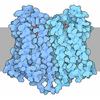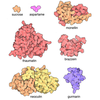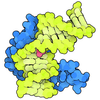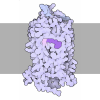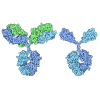+ Open data
Open data
- Basic information
Basic information
| Entry | Database: PDB / ID: 9m8p | |||||||||||||||||||||||||||
|---|---|---|---|---|---|---|---|---|---|---|---|---|---|---|---|---|---|---|---|---|---|---|---|---|---|---|---|---|
| Title | GPR3 dimer with antagonist AF64394 | |||||||||||||||||||||||||||
 Components Components | Soluble cytochrome b562,G-protein coupled receptor 3 | |||||||||||||||||||||||||||
 Keywords Keywords | MEMBRANE PROTEIN / GPCR / dimer / antagonist | |||||||||||||||||||||||||||
| Function / homology |  Function and homology information Function and homology informationsphingosine-1-phosphate receptor activity / regulation of meiotic nuclear division / regulation of metabolic process / electron transport chain / G protein-coupled receptor activity / adenylate cyclase-activating G protein-coupled receptor signaling pathway / positive regulation of cold-induced thermogenesis / periplasmic space / electron transfer activity / iron ion binding ...sphingosine-1-phosphate receptor activity / regulation of meiotic nuclear division / regulation of metabolic process / electron transport chain / G protein-coupled receptor activity / adenylate cyclase-activating G protein-coupled receptor signaling pathway / positive regulation of cold-induced thermogenesis / periplasmic space / electron transfer activity / iron ion binding / heme binding / plasma membrane / cytoplasm Similarity search - Function | |||||||||||||||||||||||||||
| Biological species |   Homo sapiens (human) Homo sapiens (human) | |||||||||||||||||||||||||||
| Method | ELECTRON MICROSCOPY / single particle reconstruction / cryo EM / Resolution: 3.42 Å | |||||||||||||||||||||||||||
 Authors Authors | Geng, C. / Jun, X. | |||||||||||||||||||||||||||
| Funding support |  China, 1items China, 1items
| |||||||||||||||||||||||||||
 Citation Citation |  Journal: Nat Commun / Year: 2025 Journal: Nat Commun / Year: 2025Title: Mechanism and function of GPR3 regulated by a negative allosteric modulator. Authors: Geng Chen / Jana Bláhová / Nico Staffen / Harald Hübner / Nadja Nunhöfer / Chen Qiu / Peter Gmeiner / Dorothee Weikert / Yang Du / Jun Xu /   Abstract: Allosteric modulators have gained substantial interest in current GPCR drug discovery. Here, we present a mechanism of allosteric modulation involving the dimerization of GPR3, a promising drug ...Allosteric modulators have gained substantial interest in current GPCR drug discovery. Here, we present a mechanism of allosteric modulation involving the dimerization of GPR3, a promising drug target for metabolic diseases and central nervous system disorders. We show that GPR3 forms constitutive homodimers in live cells and reveal that the inhibitor AF64394 functions as a negative allosteric modulator (NAM) specifically targeting dimeric GPR3. Using cryogenic electron microscopy (cryo-EM), we determine the structures of the AF64394-bound GPR3 dimer and its dimer-Gs signaling complex. These high-resolution structures reveal that AF64394 binds to the transmembrane dimer interface. AF64394 binding prevents the dissociation of the GPR3 dimer upon engagement with Gs and restrains transmembrane helix 5 in an inactive-like intermediate conformation, leading to reduced coupling with Gs. Our studies unveil a mechanism of dimer-specific inhibition of signaling with significant implications for the discovery of drugs targeting GPCRs capable of dimerization. | |||||||||||||||||||||||||||
| History |
|
- Structure visualization
Structure visualization
| Structure viewer | Molecule:  Molmil Molmil Jmol/JSmol Jmol/JSmol |
|---|
- Downloads & links
Downloads & links
- Download
Download
| PDBx/mmCIF format |  9m8p.cif.gz 9m8p.cif.gz | 107.8 KB | Display |  PDBx/mmCIF format PDBx/mmCIF format |
|---|---|---|---|---|
| PDB format |  pdb9m8p.ent.gz pdb9m8p.ent.gz | Display |  PDB format PDB format | |
| PDBx/mmJSON format |  9m8p.json.gz 9m8p.json.gz | Tree view |  PDBx/mmJSON format PDBx/mmJSON format | |
| Others |  Other downloads Other downloads |
-Validation report
| Summary document |  9m8p_validation.pdf.gz 9m8p_validation.pdf.gz | 1.7 MB | Display |  wwPDB validaton report wwPDB validaton report |
|---|---|---|---|---|
| Full document |  9m8p_full_validation.pdf.gz 9m8p_full_validation.pdf.gz | 1.7 MB | Display | |
| Data in XML |  9m8p_validation.xml.gz 9m8p_validation.xml.gz | 35.4 KB | Display | |
| Data in CIF |  9m8p_validation.cif.gz 9m8p_validation.cif.gz | 49.5 KB | Display | |
| Arichive directory |  https://data.pdbj.org/pub/pdb/validation_reports/m8/9m8p https://data.pdbj.org/pub/pdb/validation_reports/m8/9m8p ftp://data.pdbj.org/pub/pdb/validation_reports/m8/9m8p ftp://data.pdbj.org/pub/pdb/validation_reports/m8/9m8p | HTTPS FTP |
-Related structure data
| Related structure data |  63717MC  9m88C  9m8vC M: map data used to model this data C: citing same article ( |
|---|---|
| Similar structure data | Similarity search - Function & homology  F&H Search F&H Search |
- Links
Links
- Assembly
Assembly
| Deposited unit | 
|
|---|---|
| 1 |
|
- Components
Components
| #1: Protein | Mass: 50446.375 Da / Num. of mol.: 2 Source method: isolated from a genetically manipulated source Source: (gene. exp.)   Homo sapiens (human) Homo sapiens (human)Gene: cybC, GPR3, ACCA Production host:  Spodoptera aff. frugiperda 1 BOLD-2017 (butterflies/moths) Spodoptera aff. frugiperda 1 BOLD-2017 (butterflies/moths)References: UniProt: P0ABE7, UniProt: P46089 #2: Chemical | #3: Chemical | ChemComp-1DO / #4: Chemical | ChemComp-A1AJD / ( Mass: 128.212 Da / Num. of mol.: 4 / Source method: obtained synthetically / Formula: C8H16O #5: Chemical | Mass: 393.869 Da / Num. of mol.: 2 / Source method: obtained synthetically / Formula: C21H20ClN5O / Feature type: SUBJECT OF INVESTIGATION Has ligand of interest | Y | Has protein modification | Y | |
|---|
-Experimental details
-Experiment
| Experiment | Method: ELECTRON MICROSCOPY |
|---|---|
| EM experiment | Aggregation state: PARTICLE / 3D reconstruction method: single particle reconstruction |
- Sample preparation
Sample preparation
| Component | Name: GPR3 dimer with antagonist AF64394 / Type: COMPLEX / Entity ID: #1 / Source: RECOMBINANT |
|---|---|
| Molecular weight | Value: 0.1 MDa / Experimental value: YES |
| Source (natural) | Organism:  Homo sapiens (human) Homo sapiens (human) |
| Source (recombinant) | Organism:  Spodoptera aff. frugiperda 1 BOLD-2017 (butterflies/moths) Spodoptera aff. frugiperda 1 BOLD-2017 (butterflies/moths) |
| Buffer solution | pH: 7.5 / Details: 20mM NaCl, 100mM Hepes, 0.003% LMNG, 0.001% GDN |
| Specimen | Embedding applied: NO / Shadowing applied: NO / Staining applied: NO / Vitrification applied: YES |
| Vitrification | Cryogen name: ETHANE |
- Electron microscopy imaging
Electron microscopy imaging
| Experimental equipment |  Model: Titan Krios / Image courtesy: FEI Company |
|---|---|
| Microscopy | Model: TFS KRIOS |
| Electron gun | Electron source:  FIELD EMISSION GUN / Accelerating voltage: 300 kV / Illumination mode: FLOOD BEAM FIELD EMISSION GUN / Accelerating voltage: 300 kV / Illumination mode: FLOOD BEAM |
| Electron lens | Mode: BRIGHT FIELD / Nominal defocus max: 2000 nm / Nominal defocus min: 1200 nm |
| Image recording | Electron dose: 1.12 e/Å2 / Film or detector model: GATAN K3 BIOQUANTUM (6k x 4k) |
- Processing
Processing
| CTF correction | Type: PHASE FLIPPING AND AMPLITUDE CORRECTION |
|---|---|
| 3D reconstruction | Resolution: 3.42 Å / Resolution method: FSC 0.143 CUT-OFF / Num. of particles: 98600 / Symmetry type: POINT |
 Movie
Movie Controller
Controller





 PDBj
PDBj
